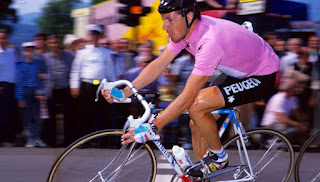Today is St. Patrick's Day. Here is a message for the President whose name I dare not say:
Actually, it might be even more appropriate for the guy he appointed to direct the Environmental Protection Agency!
Yes, "Go Green" on St. Patrick's Day! And every other day of the year. That might just be a good all-around political philosophy. Forget the Democrats and Republicans. Go Green!
Today is as good a day as any to think about the great Irish cyclists. I am one of the many people who regard Stephen Roche as the greatest of all. He remains, to date, the only Irishman to win the Tour de France and one of the few from any nation to achieve a "Triple Crown" with victories in the Tour de France, Giro d'Italia and Vuelta a Espana in 1987. In addition, he won or placed highly in a number of "classics" and proved himself in a wide variety of courses, from mountains to time trials.
The reason why he will never have the status of Jacques Anquetil, Eddy Mercx, Bernard Hinault and Miguel Indurain--whom I, like many other fans, see as the "Big Four"--is that his career was cut short by a chronic knee problem. But the reason why he's beloved is that probably no other racer's form was as graceful as his. He really was, to use a cliche, poetry in motion.
Roche, Sean Kelly and every other Irish rider owes a debt to Shay Elliott. In 1963, he became the first Irishman to win the maillot jaune, which he wore for three days during that year's Tour.
Unfortunately for him, his career spiraled downward because of financial and marital problems. Worse, he became a pariah in the peloton when he sold a story to a newspaper about drug-taking in the sport. Two weeks after his father died, he was found dead in the living quarters above the family business premises. The cause of his death, at age 36, was a gunshot wound.
The Route de Chill Mhantain, a race held every May, was named for Elliott after his death. It's considered the most prestigious race in Ireland besides the national championships.
About the Irish Road Race and Time Trial Championships: Last year, they were won by a fellow named Nicolas Roche. Yes, he's Stephen's son.
Actually, it might be even more appropriate for the guy he appointed to direct the Environmental Protection Agency!
Yes, "Go Green" on St. Patrick's Day! And every other day of the year. That might just be a good all-around political philosophy. Forget the Democrats and Republicans. Go Green!
Today is as good a day as any to think about the great Irish cyclists. I am one of the many people who regard Stephen Roche as the greatest of all. He remains, to date, the only Irishman to win the Tour de France and one of the few from any nation to achieve a "Triple Crown" with victories in the Tour de France, Giro d'Italia and Vuelta a Espana in 1987. In addition, he won or placed highly in a number of "classics" and proved himself in a wide variety of courses, from mountains to time trials.
The reason why he will never have the status of Jacques Anquetil, Eddy Mercx, Bernard Hinault and Miguel Indurain--whom I, like many other fans, see as the "Big Four"--is that his career was cut short by a chronic knee problem. But the reason why he's beloved is that probably no other racer's form was as graceful as his. He really was, to use a cliche, poetry in motion.
Roche, Sean Kelly and every other Irish rider owes a debt to Shay Elliott. In 1963, he became the first Irishman to win the maillot jaune, which he wore for three days during that year's Tour.
Unfortunately for him, his career spiraled downward because of financial and marital problems. Worse, he became a pariah in the peloton when he sold a story to a newspaper about drug-taking in the sport. Two weeks after his father died, he was found dead in the living quarters above the family business premises. The cause of his death, at age 36, was a gunshot wound.
The Route de Chill Mhantain, a race held every May, was named for Elliott after his death. It's considered the most prestigious race in Ireland besides the national championships.
About the Irish Road Race and Time Trial Championships: Last year, they were won by a fellow named Nicolas Roche. Yes, he's Stephen's son.










